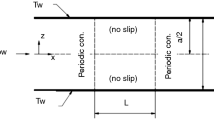Abstract
The implementation of solid-fluid boundary condition has been a major challenge for dissipative particle dynamics (DPD) method. Current implementations of boundary conditions usually try to approach a uniform density distribution and a velocity profile close to analytical solution. The density oscillations and slip velocity are intentionally eliminated, and different wall properties disappear in the same analytical solution. This paper develops a new wall model that combines image and frozen particles and a new strategy to emphasize different wall properties especially wettabilities. The strategy first studies the realistic wall-fluid system by molecular dynamics (MD) simulation depending on physical parameters. Then, a DPD simulation is used to match the density and velocity profiles with the new wall model. The obtained DPD parameters can simulate the systems with the same wall and fluid materials. With this method, a simulation of the Poiseuille flow of liquid argon with copper walls is presented. Other walls with super-hydrophilic, hydrophilic, and hydrophobic wettabilities are also simulated. The limitations of the analytical solution and the effect of the wall-fluid interaction are discussed. The results show that the method suggested in this paper can simulate the mesoscale behavior of the microchannel flow related to realistic systems.
Similar content being viewed by others
References
PIVKIN, I. V. and KARNIADAKIS, G. E. A new method to impose no-slip boundary conditions in dissipative particle dynamics. Journal of Computational Physics, 207(1), 114–128 (2005)
KEAVENY, E. E., PIVKIN, I. V., MAXEY, M., and KARNIADAKIS, G. E. A comparative study between dissipative particle dynamics and molecular dynamics for simple- and complex-geometry flows. The Journal of Chemical Physics, 123(10), 104107 (2005)
HOOGERBRUGGE, P. J. and KOELMAN, J. Simulating microscopic hydrodynamic phenomena with dissipative particle dynamics. Europhysics Letters, 19(3), 155–160 (1992)
ESPAÑOL, P. and WARREN, P. Statistical mechanics of dissipative particle dynamics. Europhysics Letters, 30(4), 191–196 (1995)
LI, Z., BIAN, X., TANG, Y. H., and KARNIADAKIS, G. E. A dissipative particle dynamics method for arbitrarily complex geometries. Journal of Computational Physics, 355, 534–547 (2018)
WILLEMSEN, S., HOEFSLOOT, H., and IEDEMA, P. No-slip boundary condition in dissipative particle dynamics. International Journal of Modern Physics C, 11(5), 881–890 (2000)
DUONG-HONG, D., PHAN-THIEN, N., and FAN, X. An implementation of no-slip boundary conditions in the DPD. Computational Mechanics, 35(1), 24–29 (2004)
PIVKIN, I. V. and KARNIADAKIS, G. E. Controlling density fluctuations in wall-bounded dissipative particle dynamics systems. Physical Review Letters, 96(20), 206001 (2006)
YARNELL, J., KATZ, M., WENZEL, R., and KOENIG, S. Structure factor and radial distribution function for liquid argon at 85 °K. Physical Review A, 7(6), 2130–2144 (1973)
GROOT, R. and WARREN, P. Dissipative particle dynamics: bridging the gap between atomistic and mesoscopic simulation. Journal of Chemical Physics, 107(11), 4423–4435 (1997)
PLIMPTON, S. Fast parallel algorithms for short-range molecular dynamics. Journal of Computational Physics, 117(1), 1–19 (1995)
KUMAR, A., ASAKO, Y., ABU-NADA, E., KRAFCZYK, M., and FAGHRI, M. From dissipative particle dynamics scales to physical scales: a coarse-graining study for water flow in microchannel. Microfluidics and Nanofluidics, 7(4), 467–477 (2009)
GROOT, R. and RABONE, K. Mesoscopic simulation of cell membrane damage, morphology change and rupture by nonionic surfactants. Biophysical Journal, 81(2), 725–736 (2001)
FRENKEL, D. and SMIT, B. Understanding Molecular Simulations: From Algorithms to Applications, 2nd ed., Academic, New York (2002)
BACKER, J., LOWE, C., HOEFSLOOT, H., and IEDEMA, P. Poiseuille flow to measure the viscosity of particle model fluids. Journal of Chemical Physics, 122(15), 154503 (2005)
SARKARA, S. and SELVAM, R. P. Molecular dynamics simulation of effective thermal conductivity and study of enhanced thermal transport mechanism in nanofluids. Journal of Applied Physics, 102(7), 074302 (2007)
GENNES, P. G. Wetting: statics and dynamics. Review of Modern Physics, 57(3), 827–863 (1985)
JIANG, C., OUYANG, J., LIU, Q., LI, W., and ZHUANG, X. Studying the viscosity of methane fluid for different resolution levels models using Poiseuille flow in a nano-channel. Microfluidics and Nanofluidics, 20(12), 157 (2016)
FARAJI, F., RAJABPOUR, A., and KOWSARY, F. Temperature profile for nanoscale Poiseuille flow: a multiscale study. Journal of Mechanical Science and Technology, 30(2), 803–807 (2016)
Author information
Authors and Affiliations
Corresponding author
Rights and permissions
About this article
Cite this article
Wang, Y., She, J. & Zhou, Z. A new model for dissipative particle dynamics boundary condition of walls with different wettabilities. Appl. Math. Mech.-Engl. Ed. 42, 467–484 (2021). https://doi.org/10.1007/s10483-021-2697-9
Received:
Revised:
Published:
Issue Date:
DOI: https://doi.org/10.1007/s10483-021-2697-9
Key words
- dissipative particle dynamics (DPD)
- molecular dynamics (MD)
- wall-fluid interaction
- image particle
- wettability




